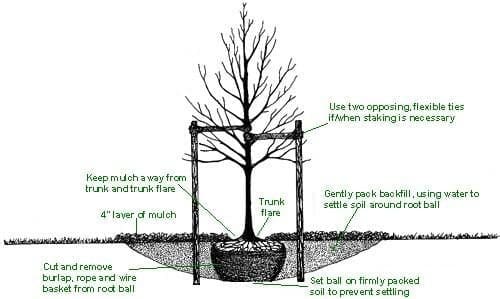Sometimes, a tree in your yard can be problematic, either due to its location or simply personal preference. However, while disposing of a dead or diseased tree is often the only recourse at hand, a healthy tree should not go to waste.
When you’re dealing with an unwanted tree, you can easily dig it up and transplant it to another location, be it another location on your property or somewhere else. Many homeowners with a green thumb would gladly take a healthy tree of your hands. And truthfully, transplanting a tree isn’t that challenging, provided you understand what you’re doing.
Why You Would Want to Transplant a Tree
Let’s say you have a beloved pet you could no longer take care of. The reason doesn’t matter—all that matters is you can no longer give it to the TLC it needs to be happy and healthy. You wouldn’t toss the pet in a ditch, or even worse, leave it in its place to grow even sicker until it succumbs to its illness. The same should be true for any of the trees in your yard—they’re beautiful, living creatures that persevered for years to become what you see today. They deserve to live a full life, provided they’re still healthy.
Thus, the prospect of transplanting a tree comes to mind. Whether or not you plan to move it to a healthier section of your yard where it can thrive or give it to a caring friend with the time and knowledge to care for it, transplanting a tree is a relatively simple and rewarding process.
When is the Best Time to do It?
A transplanted tree thrives best when the weather is fair. The worst thing for a newly transplanted tree is too much heat and/or sun, so transplanting in the summer months is not advisable. Yet, in the winter months, the ground is often frozen solid, making it nearly impossible to dig up the ground.
The sweet spot for transplanting your tree is typically in late Winter through early Spring, when the sun isn’t too intense but the ground is pliable enough to easily dig through. In a pinch, you could try transplanting your tree in the Fall but your mileage may vary—the sun may still be too stressful to the uprooted tree. Of course, you should do your research on your specific tree to ascertain the best time for transplanting—not all trees thrive in the same conditions.
What You’ll Need
Luckily transplanting a tree doesn’t require a large array of equipment. Most of what you need you may already have lying around in your garden shed.
- Shovel/Spade—Get a shovel that’ll make easy work on digging up your tree without being so big that it could damage it inadvertently. To transplant a small tree, even a spade would work.
- Tarp —Any standard tarp will suffice, provided it’s large enough to fit the circumference of the root ball. If you plan to transplant a large tree, invest in the biggest tarp you can find.
- Garden Hose — You’ll need a hose or, at the very least, a reliable source of water, especially if you need to transplant a big tree with a lot of roots.
- Tape Measure — A tape measure is the easiest tool to measure the circumference of your root ball and the size of the hole you’ll dig to transplant the tree.
- Loppers —If you don’t have a pair, find a good, durable pair of loopers at your nearest hardware store. Loppers are large pruning shears.
- Mulch —A good bag of mulch is necessary for filling the hole left from transplanting the tree as well as to fill around the new transplanted zone.
How to Dig up the Tree
Project Length: Plan for a whole day and be pleasantly surprised if it takes less time.
Find an Optimal Location
Now is the time to choose an optimal location for your tree. If the tree wasn’t getting enough sunlight or nourishment where it once was, ensure the new location will provide those things. This is the time to do your research on what exactly your tree needs to thrive and choose a new location accordingly.
Do not forget to call the “Call Before You Dig” number associated with your region. The last thing you want to do is disrupt a municipal line—the results could be catastrophic, expensive, or both.
Measure the Root Ball
Using your tape measure, measure the diameter of the trunk of the tree. Most footballs will be about 11 times that circumference. If still in doubt, don’t be afraid to do some preliminary digging to see if you can get a better sense of the size of the root ball. After all, your new hole will need to accommodate the whole thing.

Measure & Dig a New Hole
The rule of thumb is to dig a hole that is twice the diameter of the root ball you just estimated. However, you may want to dig your new hole slightly more shallow than the old hole—giving your roots too much vertical room could cause water to pool, stagnant, and rot the roots of your tree. In that same regard, keep the soil in your new hole relatively compacted—the roots will easily penetrate even the most compacted dirt and dirt that is too loose will potentially rot the tree’s roots.
It’s also important to dig your new hole before you unearth the tree. Once your tree is removed from the ground time is of the essence. The last thing you want to do is to keep your tree exposed to the elements while you dig a hole.
Extricate the Tree
With the new hole dug, use your shovel to dig a parameter around your tree that is at least three feet around. From there, explore the ground to find the mass of roots that encompasses the root ball. You’ll want to keep the root ball in its entirety. If the tree is a large one, then use your pair of (sharp) loppers to cut through the difficult mass of roots while keeping as much intact as possible.
As you dig, you should have a sense of the weight of the tree you’re about to remove. Be prepared to have someone on the sidelines to help you lift the tree if it seems like it will be too heavy for one person.
Transport the Tree
With your tarp set down and spread out on the ground, quickly transfer your tree onto it. Time is of the essence at this stage—you want to limit the tree’s exposure as much as possible.
Drag the tarp and tree (using the tarp as a makeshift sled)to the new hole and slide it into the hole, adjusting the tree so it stands upright. You’ll want to ensure the transplanted tree is at the same depth as it was previously, or slightly higher. Planting your tree too low will cause undue stress to its root system.
Once placed in the hole, begin shoveling soil over the roots, watering with your garden hose as you work. Watering the soil as you shovel it will ensure it’s compacted, minimizing the amount of settling after you’d fully transplanted the tree. Once you’re finished transplanting the tree, create a mound of earth around the tree in a ring, which will create a basin to catch water and ensure that the tree’s sensitive roots have enough hydration while it works on re-rooting itself.
Nurture the Newly Transplanted Tree to Ensure It Thrives
Don’t just leave the tree to the elements once you’ve finished transplanting. While your work as transplanter is complete, your role is now that of caretaker. Start by spreading a 4-inch layer of mulch around the base of the tree while leaving a 3-inch gap around the immediate base for air circulation. Mulch will provide extra nourishment but you need to pay close attention to the amount of water your newly transplanted tree receives.
In its first year, the tree may seem anemic in appearance. But keep up your watering and give it more attention than the rest of your greenery. With enough water and plenty of TLC, your tree should be firmly rooted and back to its original verdure by year 2.
Quick Tips: Small & Large Transplants
- Any tree larger than 3 to 4 inches in diameter should be dug up and transplanted by a professional. The process is too shocking if done by hand.
- If you have to have the tree and the subsequent root ball out of the soil for longer than a few hours, wrap the root ball in a moistened burlap wrap and keep it wet until you’re ready to replant.
- If you need to move a tree in the hot sun, then you should be prepared to provide plenty of shade after the transplantation is complete—your tree’s leaves will be extra susceptible to the sun’s heat.
Final Thoughts
Taking care of trees can sometimes be a hassle, which is why we have created this guide for you. However, if this business still seems difficult, we are always ready to help! We at Earth Development can help you make your home territory look good with our landscape maintenance services from tree care services to lawn maintenance. Contact us now!
